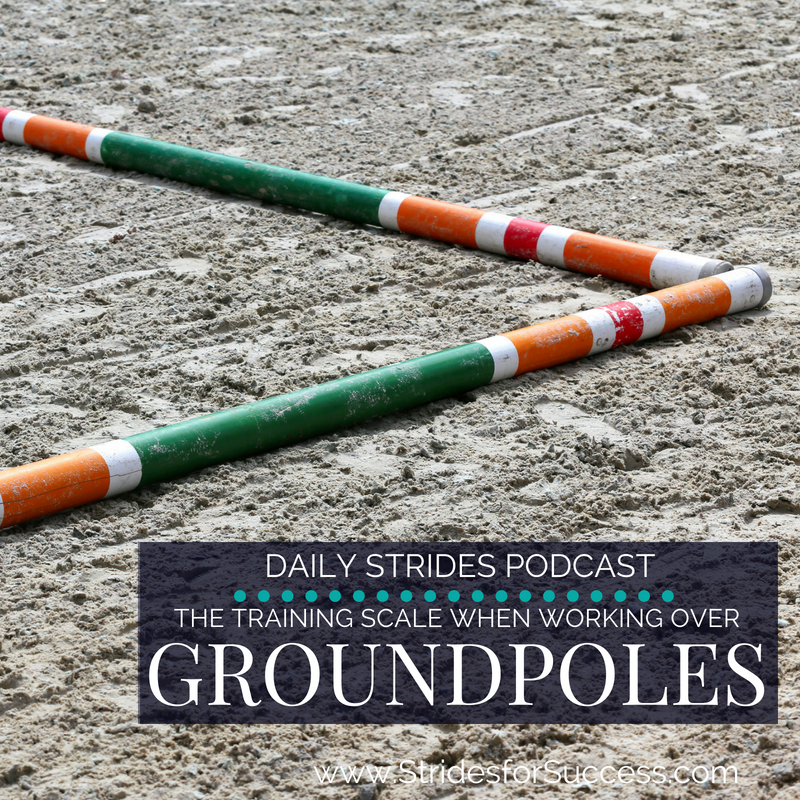
What this episode is all about:-
- Rhythm & Relaxation
- Suppleness
- Contact & Connection
- Impulsion & Straightness
Groundpoles… So many riders work with them on a regular basis with their horses. However many riders struggle to work on specific areas in their training while using the groundpoles.
In this episode of the Daily Strides Podcast we are going to focus on how you can use groundpoles in your training that will complement what you are working on. We will break down how they can be used; with a focus on the principles of the traditional training scale.
Rhythm & Relaxation
Many riders make the mistake of assuming that the pole or poles will dictate the rhythm for them. They see it as something that, because of the sequence of poles, doesn’t have to be worked or focused on.
However, very often the loss of rhythm is happening either before or after the poles – which can cancel out the benefits of working over the poles to begin with
When riding over or through groundpoles, make sure that there is consistency in the rhythm and tempo all the way through. The ‘before’, the ‘over or through’ and the ‘after’. The only way to really ensure this is happening is by becoming mindful of the rhythm to begin with.
You can also focus on consistent relaxation throughout the exercise. This is the management of the tension throughout the line you are riding.
Make sure there is no anxiety present. The same with too much energy or tension caused by over excitement or anticipation. The tension should be sufficient to get to you the poles, over or through the poles and, then, away from the poles.
Suppleness
Most riders think of suppleness as being ‘bending’ or ‘flexing’ from one side to the other. They are not wrong, suppleness is flexibility. However, when working with groundpoles, we can look at suppleness in other ways as well.
Suppleness of the joints as the horse has to lift his legs ‘higher’ to clear the poles. Suppleness through the back, tail to poll, as the horse reaches for each step.
Think of your horses back as being a rainbow shape as he works over the poles. You are on the top, in the centre of the rainbow. His hind legs are having to stretch or reach more underneath him to power through the poles. His head and neck will be working into the contact in front.
The rider must allow the horse to engage through his core, ‘lift’ his back and connect the energy through from back to front. This requires suppleness through both the horse and the rider to happen.
Contact & Connection
When that suppleness is missing, either due to the horse being stiff, or due to the rider being ‘heavy’, the horse cannot connect through. Which impacts the contact that is present as the horse works through the poles.
Rather than throwing the contact at your horse through the poles, work towards creating and maintaining a consistent contact before, during and after the poles.
You should not have to lean on your horse’s neck or withers. Your horse should not have to lean on your contact through the poles either. Rather think of it as you both agreed to go together and hold hands through the exercise.
Impulsion
Earlier we mentioned how relaxation was the management of the tension throughout the exercises or movement. Impulsion is the management of the energy. The creation, how it flows or connects through and where it is directed to.
As the horse is pushing through from the back-end or hind quarters, you are allowing that to connect through to the front. It creates the rainbow and now you are directing it to where you want it to go.
Impulsion requires suppleness and an independent seat from the rider. True impulsion requires relaxation, rhythm, suppleness and contact from the horse. When you are managing the energy, you are deciding where it will flow to, which leads to…
Straightness
Straightness over poles is when both hind legs are propelling the horse forward with an equal amount of energy. There are no leaks, no falling out, no bulges; it is just flowing through the horse.
Very often crookedness is a sign that there is a weak area, a lack of strength, which can be worked on through correct training.
Straightness will not be present, in its truest form, until much later in your horses development due to the need for symmetrical strength.
However, it can be worked towards from early in your horses schooling. It is also key to remember that the training scale applies to you as well. Your straightness is just as essential and also needs suppleness in order to develop.
Choosing a Focus for Your Groundpoles
It would be incredibly difficult to think of all of these principles every single time you ride over or through groundpoles. There is simply too much. However, I suggest choosing one and making it your focus for each ride or session.
Keep in mind that no principle of the training scale should be worked on in isolation. As you focus on the ‘one’, the others will all play a part in mastering the one.
I am going to suggest starting at the beginning, with relaxation and rhythm. Notice that as things become more difficult, you may have to go back a step of two in order to build confidence.
Happy Riding
Lorna
Links mentioned in the episode:-
